Smoked Brisket Flat (The Ultimate Guide)
on Jun 16, 2023, Updated Jun 29, 2025
This post may contain affiliate links. Please read our disclosure policy.
Smoked brisket flat, when done right, is so tender and juicy that it almost melts in your mouth. It’s part of the magic of knowing how to make good smoker recipes.
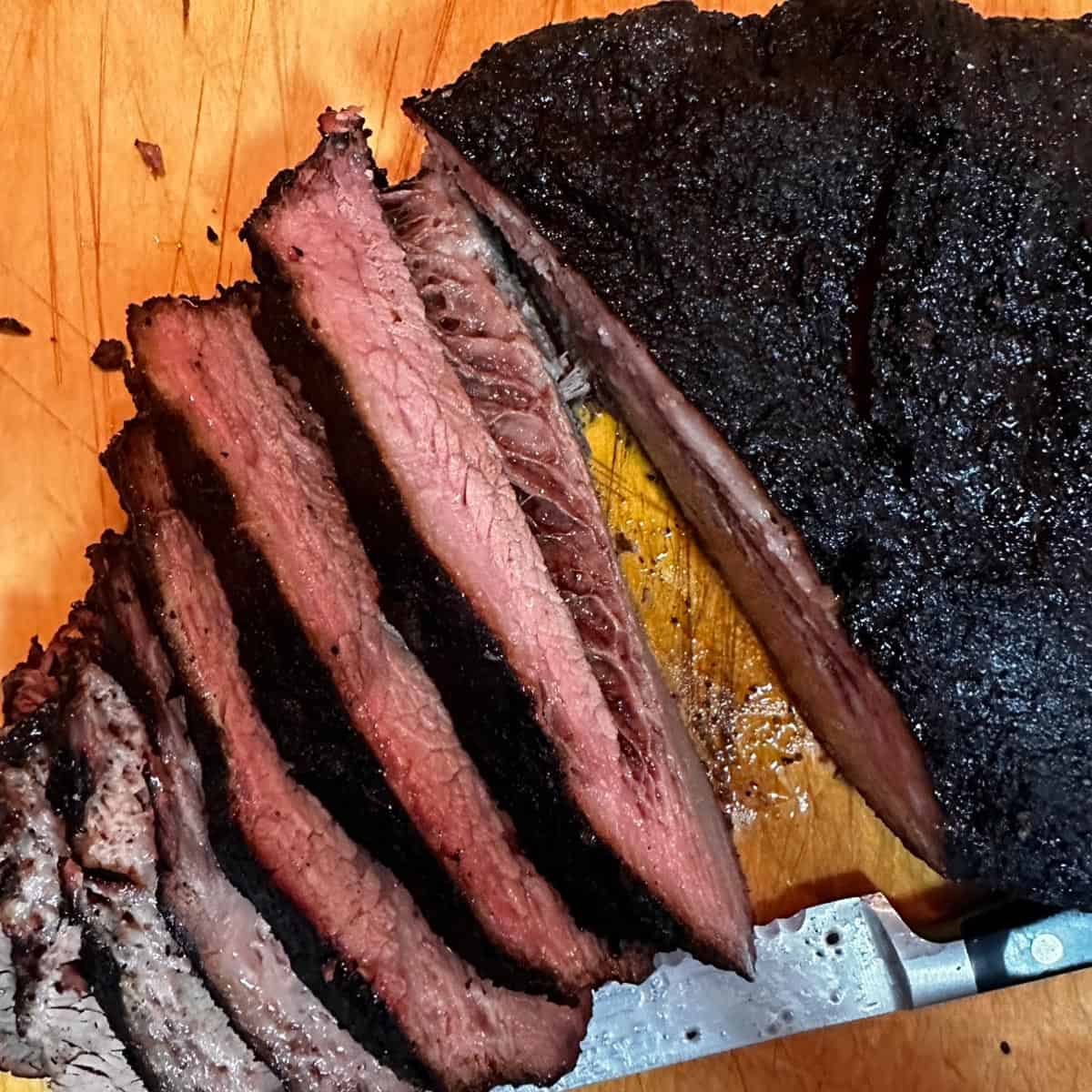
I’m not sure when I became addicted to making smoked meat but according to my family, I have a delicious affliction with my smoker. From thick, juicy smoked pork chops on a Traeger, to the best smoked salmon you’ve ever tasted, I find myself daydreaming about making great smoker recipes all the time.
I’ve even been known to spend part of Christmas day making great recipes like a whole turkey on the smoker and smoked pork loin as well!
A Quick Look at The Recipe:
✅ Ready in: 10–12 hours (including prep and smoking time)
🛒 Ingredients: 5, including salt and pepper
🍽️ Serves: 10–12
👨🍳 Difficulty: Intermediate → “Pitmaster-In-Training”
🧊 Make-Ahead Friendly: Yes. Leftover Smoked Brisket Flat will reheat well and can be sliced ahead, but brisket is best fresh off the smoker for the most flavor and tenderness.
Making a smoked brisket flat is one of the best cuts of beef to smoke and today, I will guide you how to make this every step of the way. Much of my meat smoking is inspired by friends and colleagues that have smokers and of course, Aaron Franklin, a true pitmaster legend.
What Makes This Recipe Great
- No need to get up in the middle of the night to start smoking it!
- Surprisingly simple to make with just a few basic ingredients and a low-and-slow cooking method.
- Turns a tough cut of meat into tender, juicy perfection with deep, smoky flavor and a beautiful bark.
- Perfect for backyard cookouts and makes great leftovers too.
Table of Contents
- A Quick Look at The Recipe:
- What Makes This Recipe Great
- What is a Brisket Flat?
- What You Need to Smoke a Brisket Flat
- The Best Wood for Brisket
- Ingredients for smoked brisket flat
- How to Choose the Best Brisket Flat
- How to Smoke a Brisket Flat
- Timeline for making a smoked brisket flat (10 to 12 Hours)
- How to Get a Good Bark on Brisket
- Pro Tip
- 10 Mistakes to Avoid when Smoking a Brisket Flat
- Switch it up: Variations and Substitutions
- What to Serve with Smoked Brisket Flat
- Recipe Questions and Answers
- How to use Leftover Smoked Brisket
- More Great Smoker Recipes
- Smoked Brisket Flat Recipe
What is a Brisket Flat?
When you’re smoking a brisket, it helps to know what you’re working with. A beef brisket is made up of two muscles, which commonly are knowns as the point and the flat. The brisket flat is the leaner half of a whole brisket. It’s more uniform in shape than the point of the brisket, which makes it easier to cook evenly.
Unlike the point, which has more fat and a chunkier texture, the flat is better for nice, clean slices. It doesn’t have as much marbling, so it needs a little extra care to keep it juicy, but it’s the part most people think of when they picture smoked brisket on a plate.
Smoking a brisket flat is a great alternative to smoking a whole packer brisket. It takes much less time and will generally cost you less money. Plus, you can still feed a small army with a smoked brisket flat.
One of the nice things about brisket is that it often makes enough for more than one meal. Although smoked brisket flat will always taste better the first time around, I’m also going to show you the best way to reheat a brisket.
What You Need to Smoke a Brisket Flat
Smoking a brisket, like any of the best smoker recipes, takes some planning. You need to get the timing right and you need the right equipment. Besides the ingredients, these are some of the things you will need.
Carefully planning your plan of attack with the smoker will make everything go smoother and help to give you the best smoked brisket flat possible.
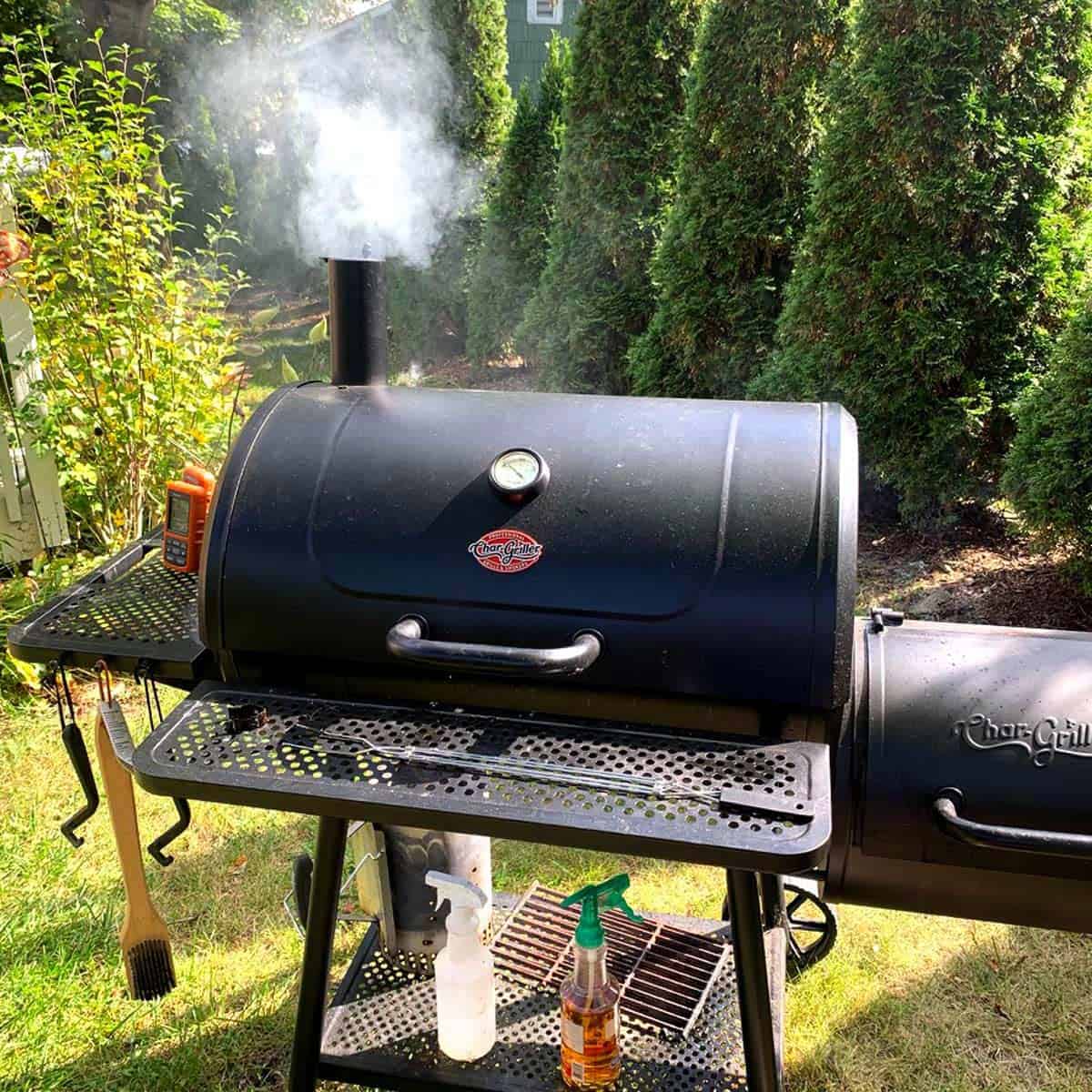
A Smoker
You can use any kind of smoker when making a brisket flat. I prefer using a wood offset smoker because I find the quality of the smoker to be the best. I generally use hickory wood when smoking a brisket but this is a matter of preference.
You don’t have to spend much money on a smoker to get great results!
Thermometers
You’ll need a couple of thermometers to monitor the meat. A wireless meat thermometer is essential as it allows you to do other things while your brisket is smoking. These will monitor both the temperature of your smoker and the internal temperature of the meat.
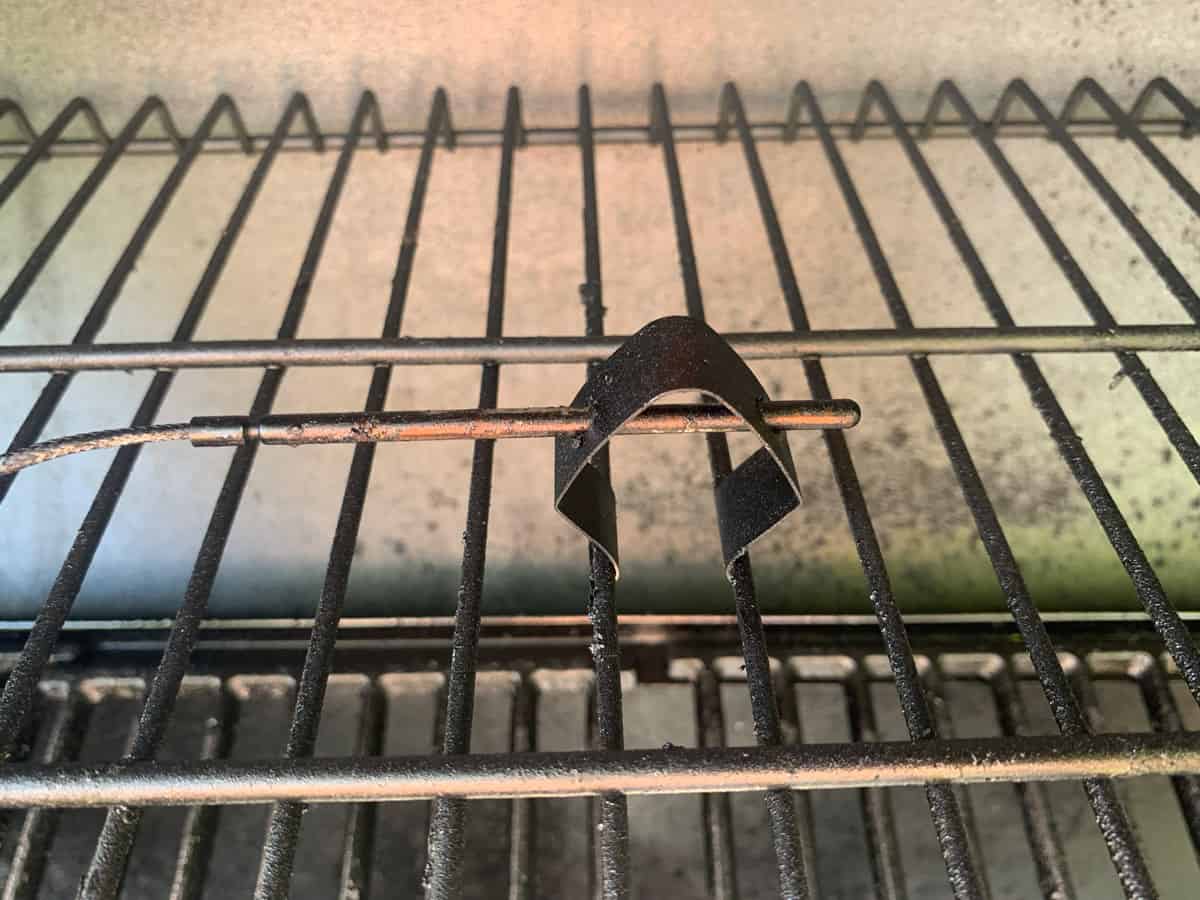
You can set alarms to notify you when you have to adjust the fire and also when your meat has reached the desired temp.
You’ll also want to use a high-quality instant-read thermometer. This is necessary to verify temps in case you get a questionable reading from your other thermometer.
EXPERT TIP: Do not rely on the built-in thermometer of your smoker. These are notoriously inaccurate and often lead to heartache and frustration when you pull your brisket after a long smoke and it is overcooked and ruined. Always calibrate your thermometers on a regular basis to ensure the best accuracy.
A Spray Bottle
You’ll need a spray bottle for many smoker recipes to keep the meat from drying out. You can use almost any liquid you want for this and some popular choices include:
- Water
- Apple Cider Vinegar
- Apple Juice
- Root Beer
Butcher wrap and Aluminum Foil
You’ll want some good non-waxed butcher paper and/or heavy-duty aluminum foil on hand for making your smoked brisket flat.
These are used to wrap the meat when it reaches the right temperature, which we will discuss later in this post.
BBQ Gloves
You’ll want a good pair of heat-resistant mitts for handling the brisket when it is piping hot.
The Best Wood for Brisket
The best wood for smoking brisket is whatever tastes best to you. If you’re smoking a brisket flat, Here’s what to know, without the fluff:
Oak is your safest bet. It burns steady and gives a solid, classic smoke flavor that won’t overpower the meat. Post oak, in particular, is a favorite in Texas barbecue for a reason. Personally, I find oak to be a little like “kissing your sister.”
Hickory is my go-to wood for smoking brisket. It is stronger and gives brisket a deep, smoky punch. It’s great if you want bold flavor, but too much can turn bitter. For a smaller flat, go light with it or mix in a milder wood. I prefer hickory for most of my delicous smoker recipes.
Pecan lands somewhere in the middle. It’s mellow but still adds depth, with a touch of sweetness. Great if you want rich smoke without the harsh edge.
Fruitwoods like cherry or apple are light and sweet. On their own, they’re too mild for brisket flat. But mixed with oak or hickory, they can round out the flavor and even darken the bark.
Pro tip: Always use seasoned wood. Wet or green wood messes with temperature and gives off dirty smoke, which will ruin your bark and your brisket. Stick with clean-burning chunks or splits, and your brisket will thank you.
Ingredients for smoked brisket flat
Here are our key players and what they bring to the table. As a general note, it is best to use less seasoning than more when smoking a brisket flat.
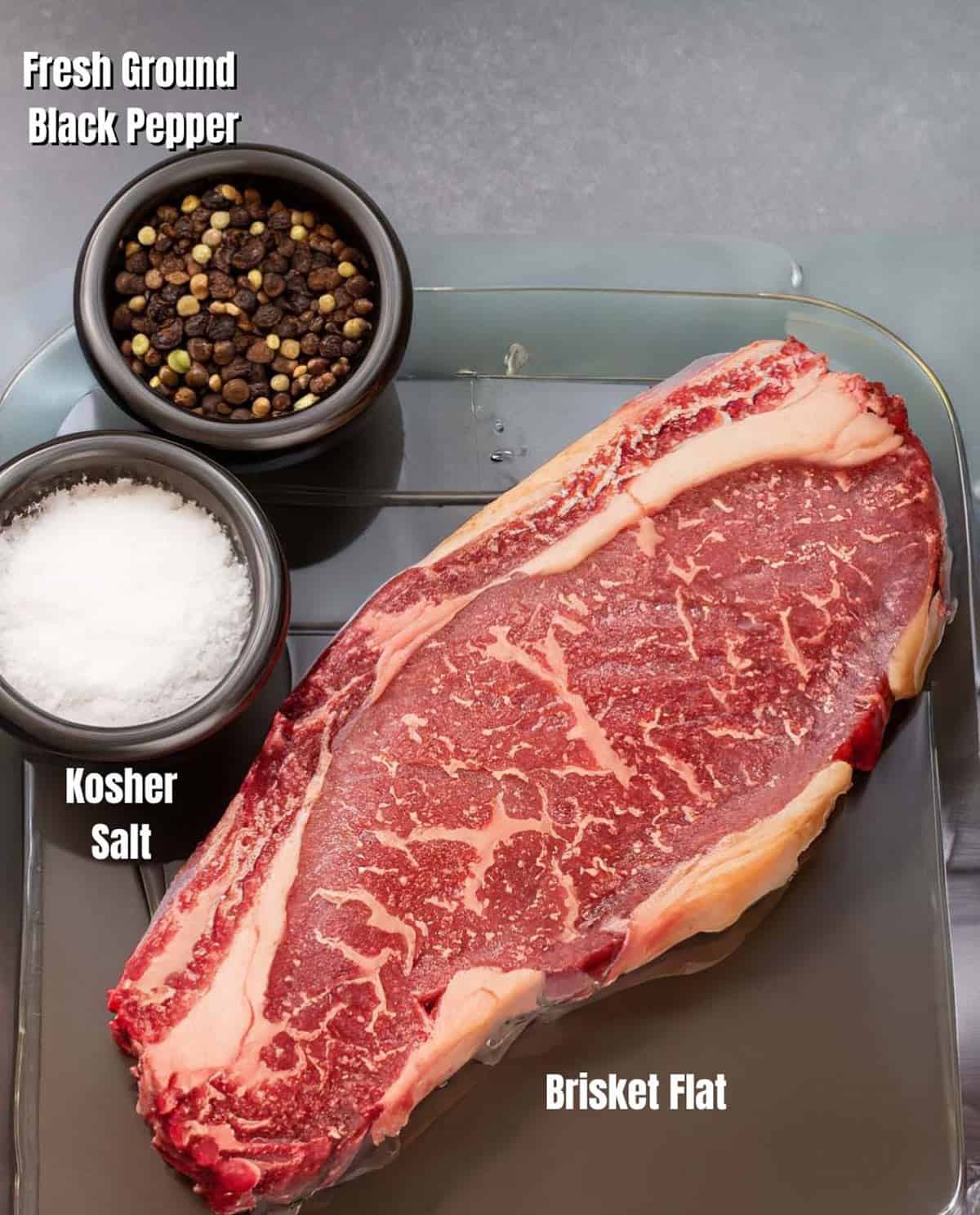
- Brisket flat: This is the leaner cut of the brisket and often easier to handle. While it has less of that yummy intramuscular fat, it’s packed full of flavor and tends to cook more evenly than the point cut, making it perfect for those tender slices.
- Kosher salt: Coarse kosher salt is a must-have for any good rub. It has a dual function in our brisket journey. Firstly, it seeps into the surface of the meat, breaking down the connective tissue that can make the meat tough. Secondly, it seasons our beautiful brisket from within, laying the foundation for a mouthwatering feast.
- Fresh ground black pepper: No respectable brisket rub would be complete without fresh ground black pepper. It adds a touch of heat and works in harmony with the kosher salt, creating a good bark during the smoking process.
How to Choose the Best Brisket Flat
You can find a brisket flat at butcher shops, meat markets, and even at places like Costco (where I’ve had great luck finding them.) If you’re looking for high-quality and convenience, you can order a brisket online from Snake River Farms.
You’ll want to consider a few things when choosing the best one.
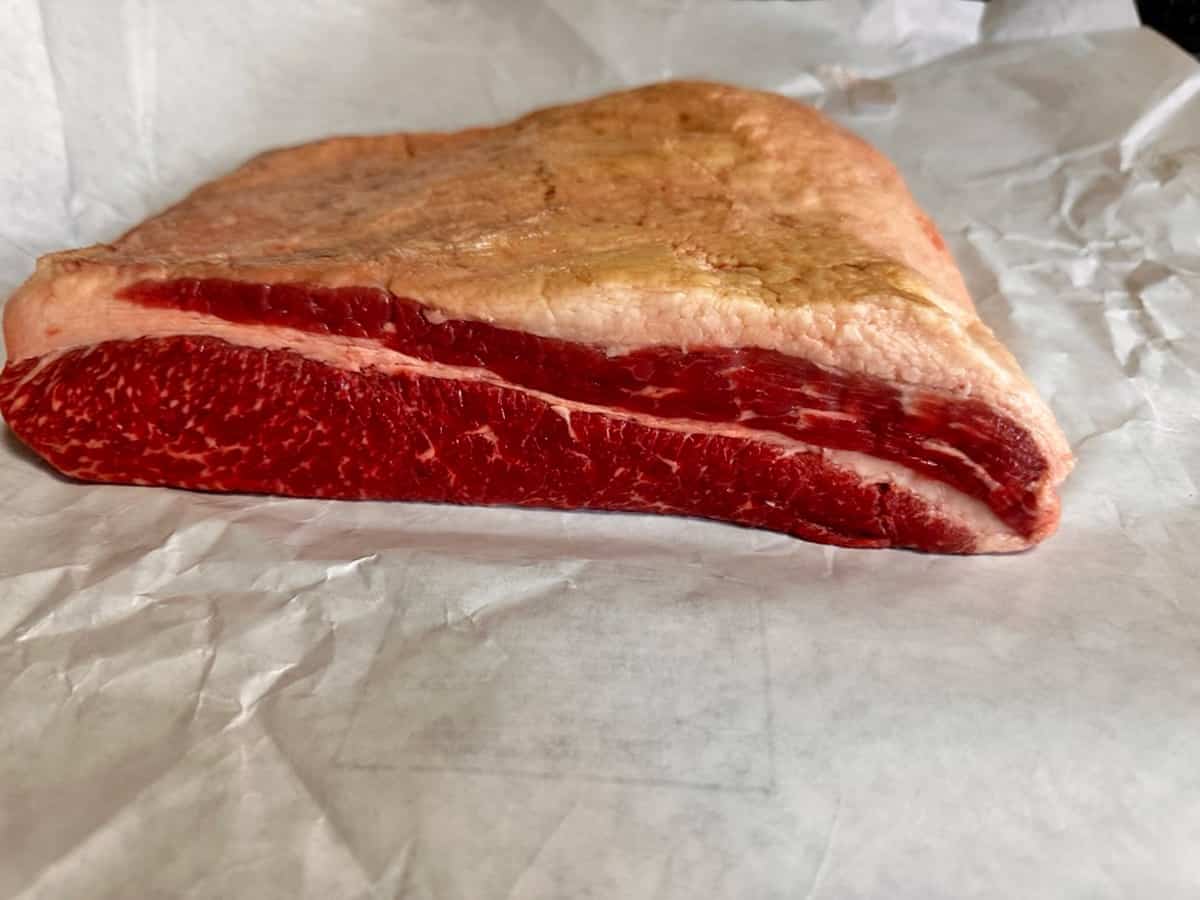
Choosing the right brisket flat is a crucial step in ensuring you cook up a delicious, mouth-watering smoked brisket. Here are some key things to look out for:
- Quality Matters: Aim for the best quality you can find. The USDA grades beef as Select, Choice, or Prime, with Prime being the best. If you can find it, go for Prime. It has the most marbling, which means more flavor and tenderness. If Prime isn’t available, Choice is a good second option.
- Size and Weight: A good rule of thumb when it comes to brisket flats is to aim for one that’s between 4 to 6 lbs. This size is easier to handle and cooks more evenly than larger cuts.
- Thickness: Look for a brisket flat that’s relatively even in thickness. This will help ensure it cooks evenly. If one side is much thicker than the other, the thin side could end up overcooked.
- Marbling: Marbling refers to the white flecks of fat within the muscle tissue (different from the fat cap on the outside of the brisket). A well-marbled brisket will be more flavorful and tender as the fat melts during cooking, so choose a brisket flat with plenty of marbling.
- The Bend Test: Hold the brisket flat by one end. It should bend or sag downwards under its own weight. If it’s too stiff, it may be too lean, which could result in a drier brisket.
- The Fat Cap: While you want the brisket flat to be lean, you still want there to be a layer of fat on one side (the fat cap). This fat will help keep the brisket moist during the long cooking process. Aim for a fat cap that’s about 1/4-inch thick.
Remember, you might not find the ‘perfect’ brisket every time, and that’s okay. Each one is unique and will have its own character. The important thing is to have fun with the process and learn from each cook.
How to Smoke a Brisket Flat
Whether you are smoking a whole packer brisket or just the flat, you need to do some planning. This is especially true if you use an offset smoker like I prefer because any way you slice it, there will be some sleep deprivation involved!
But it’s worth it. You need to do this a few times to find the best timing system for you. I promise the end result will be worth it!
Start by Prepping the Meat
Making a smoked brisket flat starts an hour or so before you fire up your smoker. There are three main parts of prepping a brisket and I will go over each one of them with you.
- Trimming the fat and silver skin.
- Allowing it to sit out.
- Seasoning the brisket.
Trim the Brisket Flat
Depending on how thick the fat cap is, you’ll need to trim a lot or a little of it off the meat. Your goal is to have about 1/4 of an inch layer of fat remaining. At this time, we will also remove the silver skin membrane.
A curved boning knife works well for this, but you can use whatever you have on hand. Be sure it’s sharp, and use extreme caution when trimming the fat as it may be slippery and difficult to get a grip on. The last thing you want is a nasty cut on your hand!
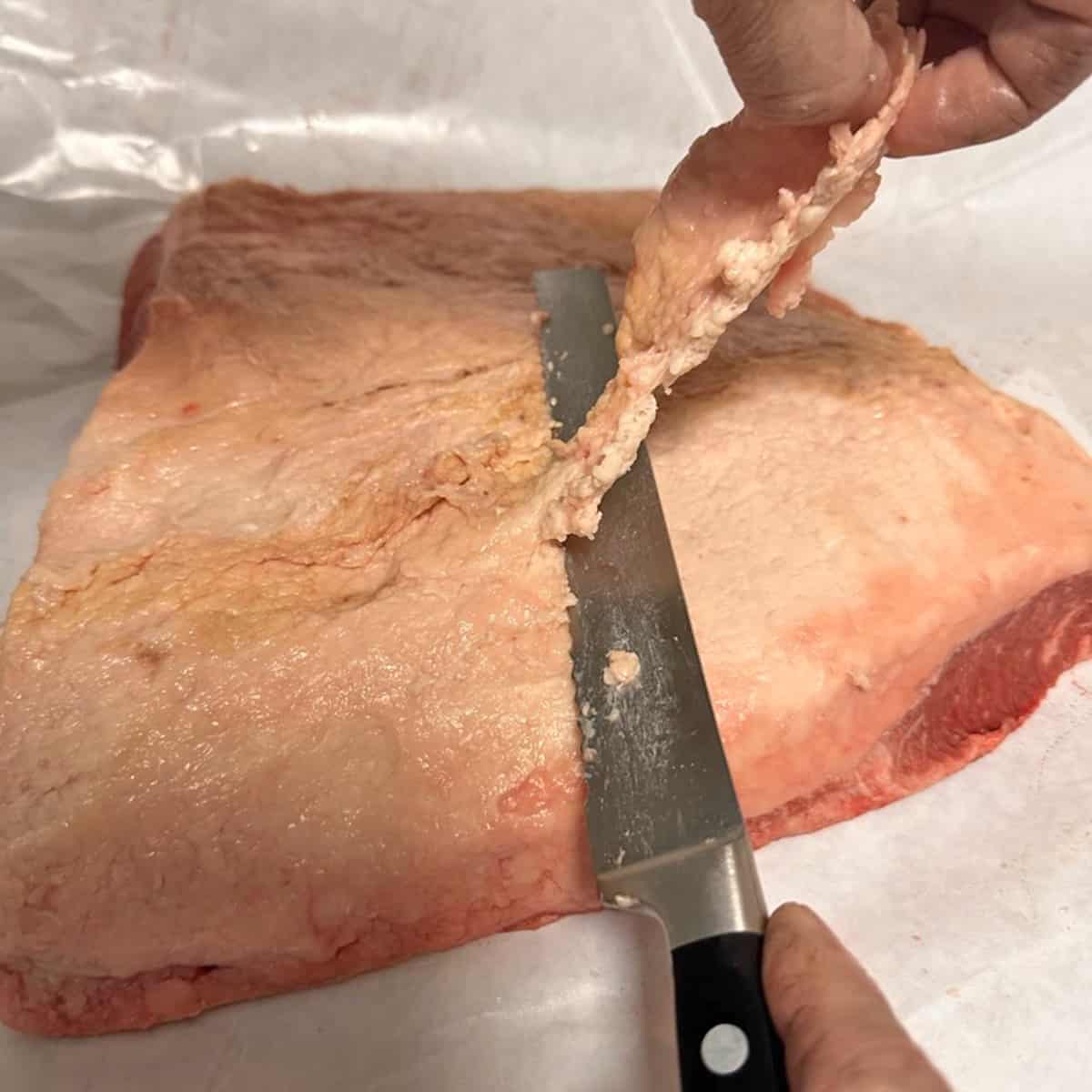
Trim the Silver Skin: You’re also going to want to remove as much of the silver skin membrane as possible.
The “silver skin” is a thin layer of tough connective tissue made primarily of a protein called collagen. It often appears silver or white, hence the name “silver skin.”
You’ll notice that is is shiny and has a slippery texture, which can make it difficult to cut through. It also doesn’t break down as easily as fat during the cooking process, and if not removed, it can become tough and chewy in the finished dish.
Trimming the silver skin from a brisket can be a bit tricky, but with a little patience and a good, sharp knife, you can get the job done effectively. Here’s a step-by-step guide:
- Get a Good Knife: A boning knife is ideal for this task. It’s flexible, sharp, and allows for precise trimming.
- Start at One End: Position the brisket on a clean cutting board with the silver skin facing up. Start at one end of the brisket, sliding the knife under the silver skin.
- Keep the Knife Angled Up: As you slide the knife, try to keep it angled slightly upwards. This will help to ensure that you’re removing the silver skin and as little meat as possible.
- Slow and Steady: Don’t rush the process. Take your time to cut away the silver skin while preserving as much of the meat underneath as you can.
- Pull and Trim: As you make progress, you can start to pull on the silver skin with your other hand, using a paper towel for grip if necessary. This will help to expose the silver skin and make it easier to trim off.
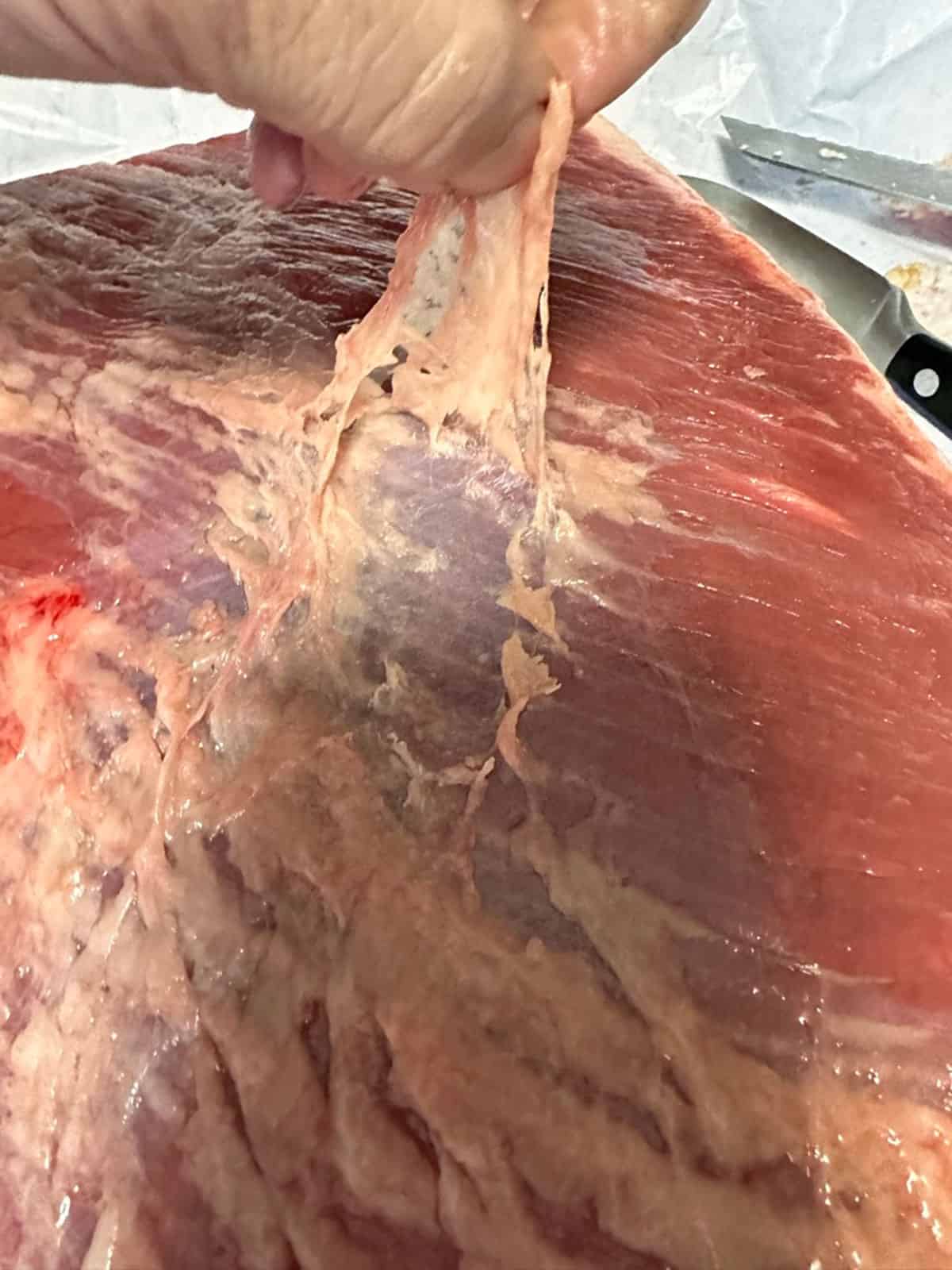
The goal isn’t to remove every last bit of silver skin but to remove as much as possible without cutting into the meat excessively. It’s okay if small bits remain, as these will typically break down during the long, slow cooking process.
This will bring the meat closer to room temperature and make the smoking process faster and more even. This first step is one of the most important ones for smoking a brisket.
EXPERT TIP: Before removing the meat from the refrigerator, place it in your freezer for a half-hour. This will make trimming the fat easier as it is a bit more solid and less squishy.
Want to Save This Recipe, Friend?
Allow the Brisket to Sit Out Before Putting it on the Smoker
You should let your brisket sit out of the refrigerator for about an hour before you plan to start smoking it. This allows it to come up to room temperature, which can help it cook more evenly once it hits the heat.
But remember, this is just a guideline. The actual time can vary based on the size of the meat and the temperature of your kitchen. For a large whole packer brisket, you might need a bit more time. For a smaller brisket flat, an hour might be just right.
Always remember food safety while doing this. You don’t want to leave the meat out for longer than two hours, which can increase the bacterial growth risk. And as always, make sure to wash your hands and any surfaces or utensils that come into contact with raw meat.
Once your brisket has come up to room temperature, it’s time to apply your rub and get it on the smoker.
Season the Brisket Flat
When it comes to seasoning a brisket flat, simple is always best. You’re going to get a lot of flavor from the smoking process and from the meat itself. You don’t want to overpower either of these components!
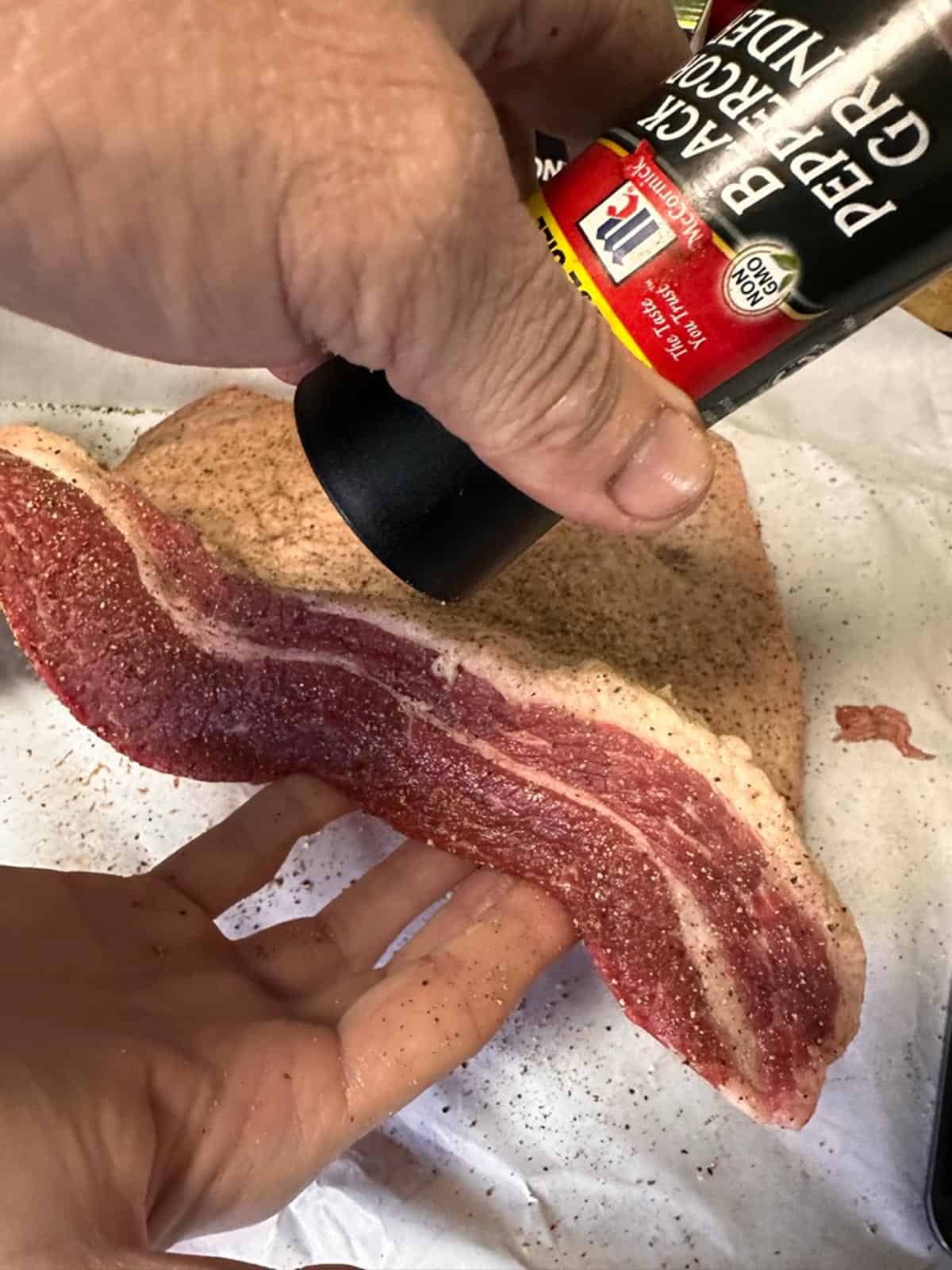
I like to use a layer of kosher salt and fresh ground pepper. That’s it! Don’t overdo it with either one of those. Usually, I season a brisket flat right after I’m done trimming it. This allows the flavors to penetrate a bit while it is sitting out and the smoker is fired up and coming up to temperature.
Preheat the Smoker
You’ll want to smoke the brisket flat at a temperature of around 250 degrees. It’s important to bring your smoker up to temperature before placing in the smoking chamber.
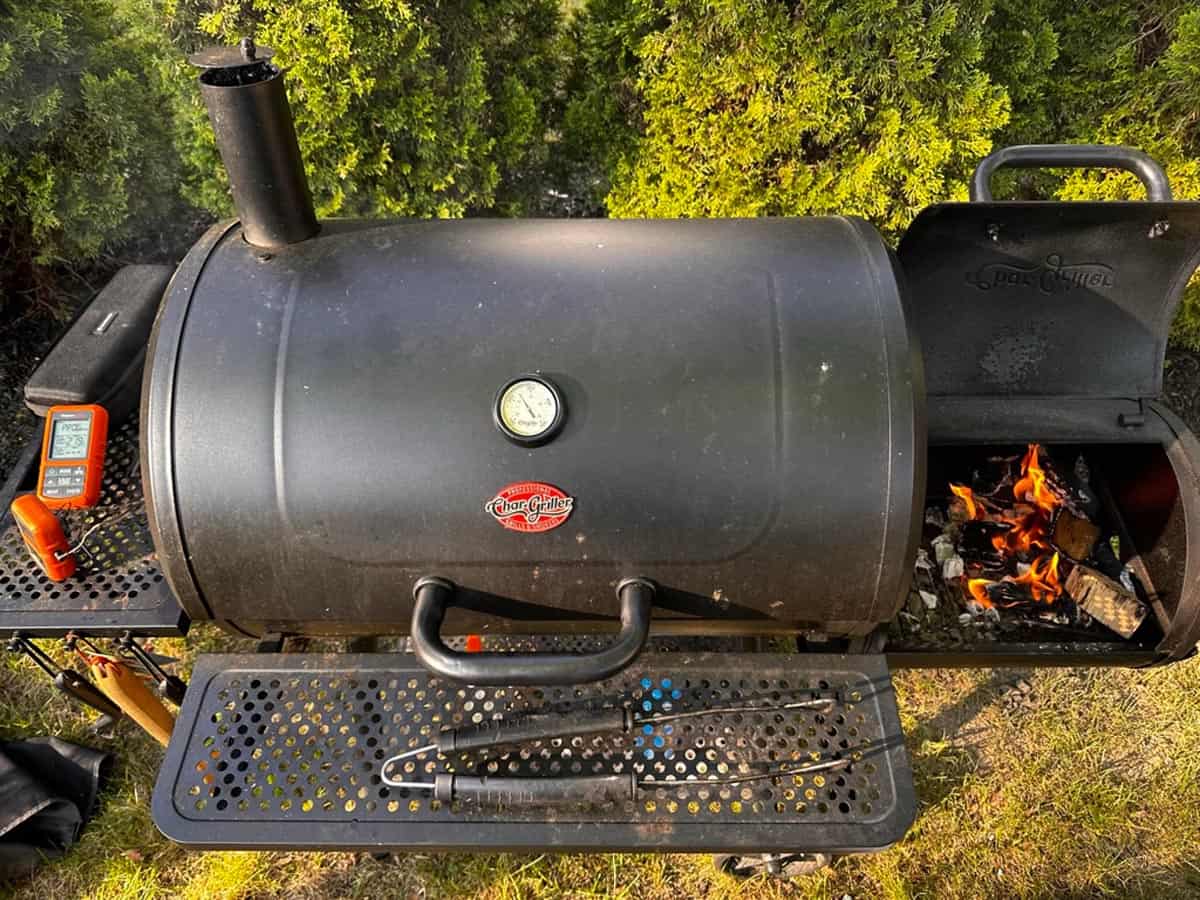
Start the fire
I like to start my fire with some lump charcoal to help get the smoker to the right temperature. Use a charcoal chimney to start your fire with a little paper at the bottom. This is better than using a liquid charcoal starter, as you won’t get that nasty chemical flavor on your meat.
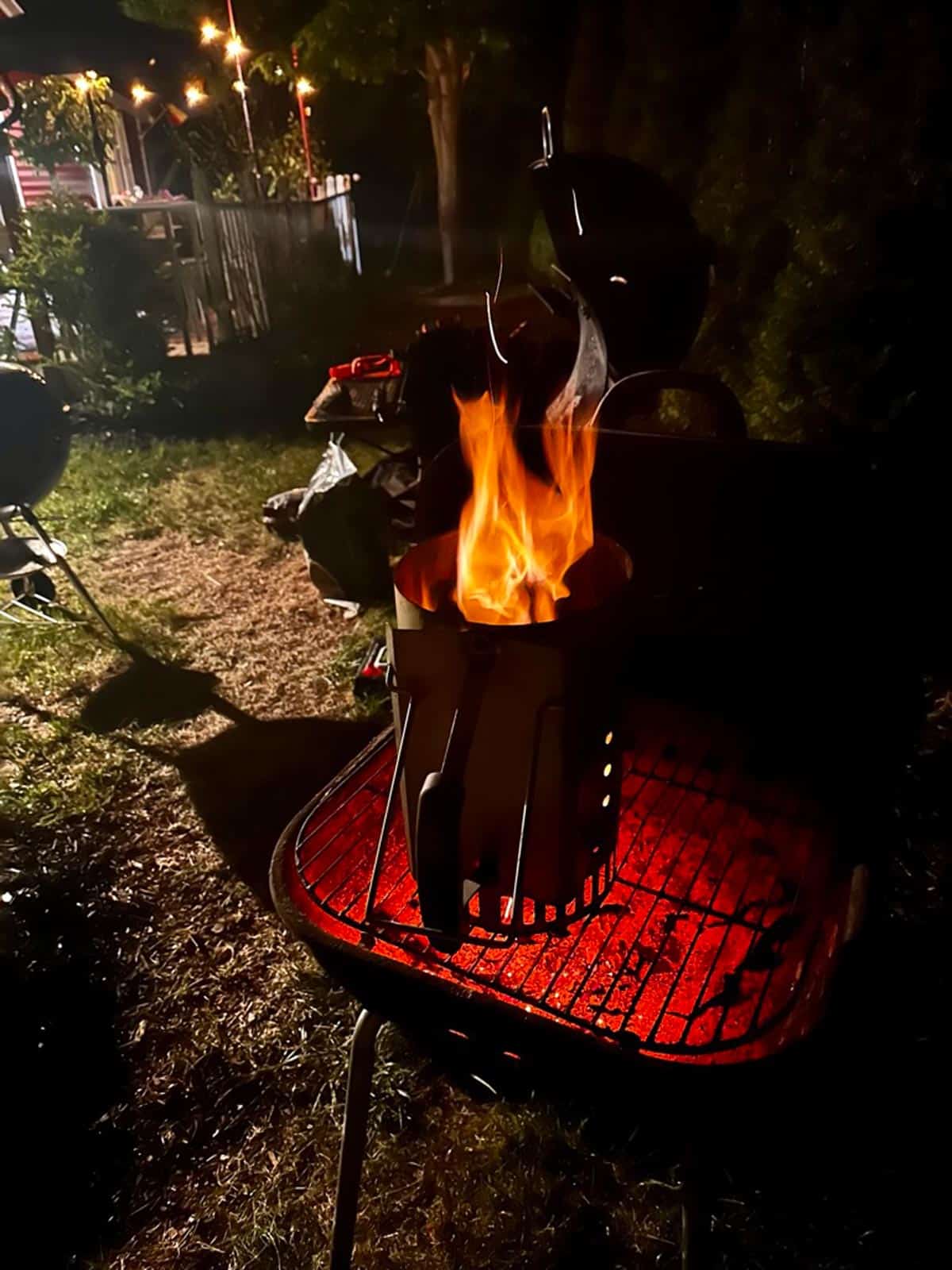
If you’re making the brisket flat on a Traeger or other type of pellet smoker, you can just set the temperature and skip this step.
Use a water pan
Using a water pan when making a smoked brisket flat. The water pan helps s in a few ways:
- It creates a humid environment that prevents the brisket from drying out during the lengthy cook time.
- The moisture from the water enhances the smoky flavor by aiding smoke adherence to the meat and helps stabilize the temperature inside the smoker.
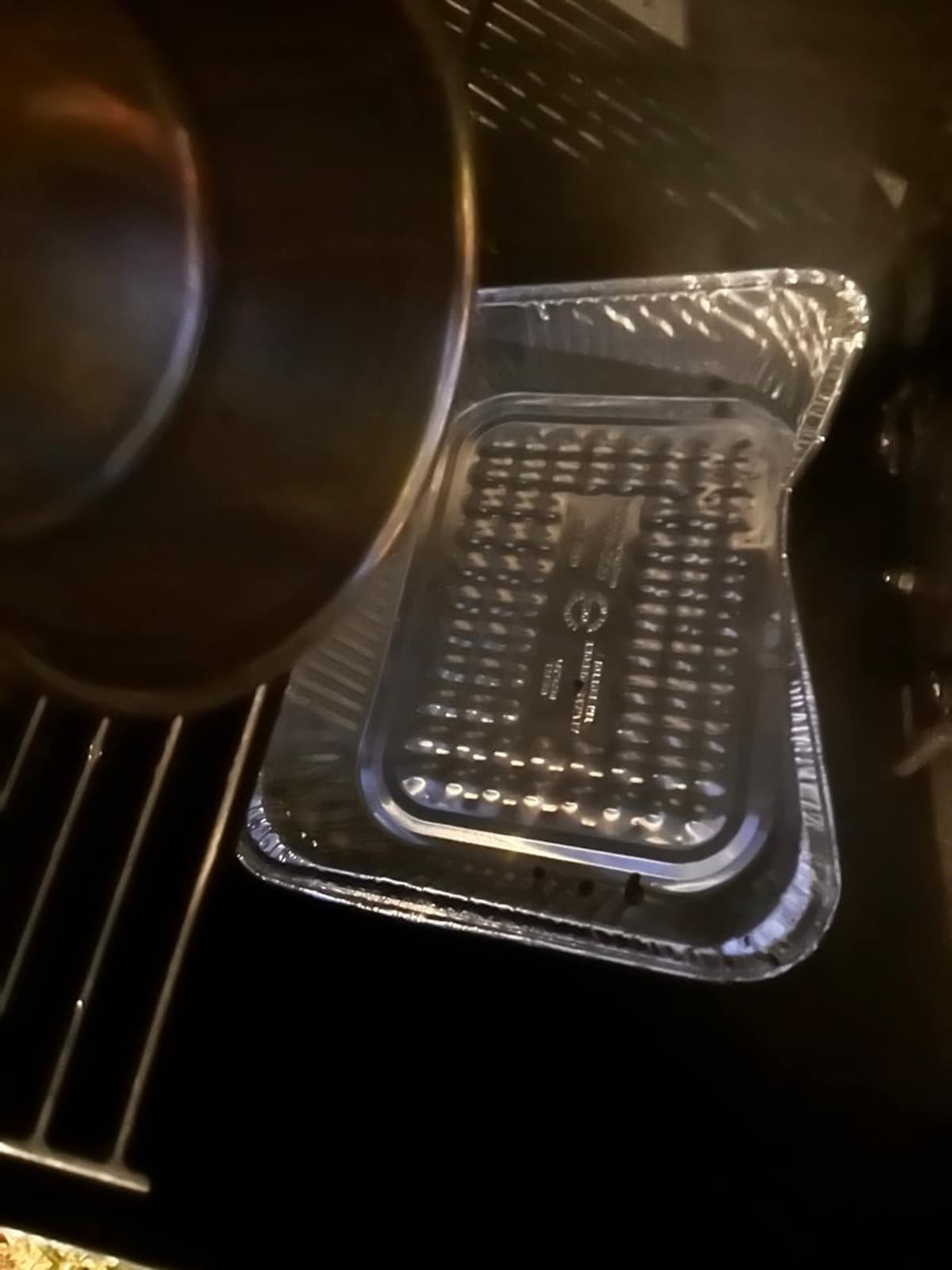
Plus, it’s a practical way to catch drippings and prevent potential flare-ups. Just remember to keep the pan topped up with water throughout the cooking process for the best results!
It’s a simple tool that can greatly improve the outcome of your smoked brisket.
EXPERT SMOKING TIP: When you fill the water pan for the first time, use water that is already hot. Do this by heating a saucepan of water on your kitchen stove. You don’t want to place cold water in a hot smoker!
Put the Brisket Flat on the Smoker
Once the temperature of your smoking chamber reaches 250 degrees, it’s show time!
EXPERT SMOKING TIP – Use a stainless steel cooling wrack instead of placing the meat directly on the smoker grates. This makes it easy to rotate the meat if you want, in case one side gets hotter than the other. It also makes it easy to transfer the meat from the smoker when you’re ready to wrap it and when it is ready to come off.
- Place the meat on your grates, fat cap up, and insert a temp probe into the thickest part of the brisket. You’ll want to allow it to smoke until it reaches an internal temp of 170°. This can take up to five hours or so, depending on the size of your brisket flat.
- Position the meat so the thickest end is closest to the heat source.
- After 90 minutes or so, use a spray bottle and spritz the meat with apple cider vinegar. You only need to do a quick spritz and do not over-saturate the meat or you’ll have steamed brisket instead of a smoked brisket flat! Repeat this every 45 minutes until we wrap it at around 170°.
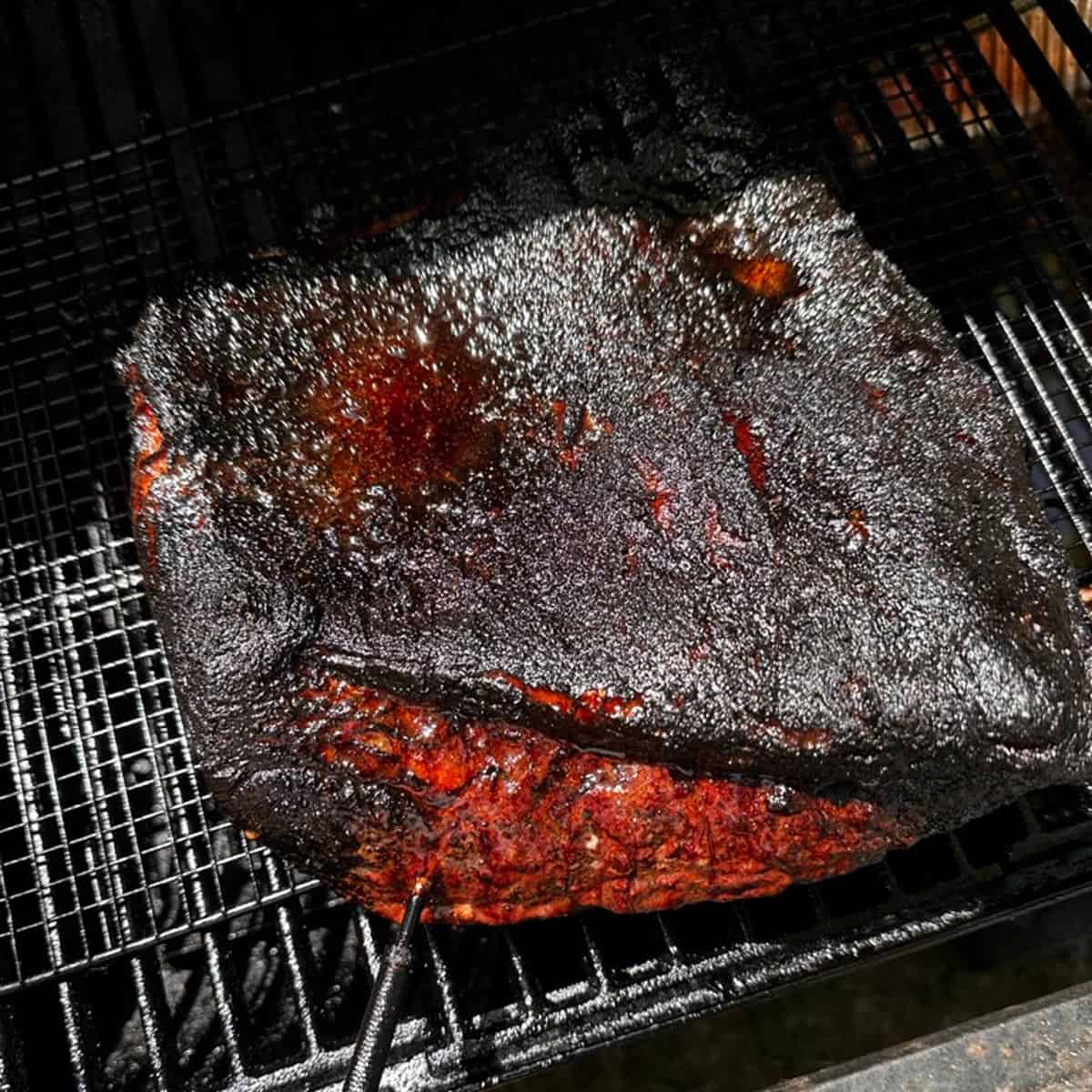
EXPERT SMOKING TIP: Whenever making a smoked brisket flat, minimize the number of times you open the smoking chamber. In other words, try not to peak! That’s why you’ll want a remote internal temp probe. And remember, “If you’re lookin’ you ain’t cookin’!”
When to Wrap a Brisket Flat
Once the internal temperature reaches 170°, it’s time to wrap the meat. I have done this as early as 150° will equally delicious results. Wrapping the meat will help lock in moisture and speed the time it takes to reach your goal temperature of 205°. You don’t have to wrap, but I can’t think of any reason not do so!
If you are a purist and a bit of a masochist, you can finish the brisket on the smoker.
On the other hand, if you’ve had enough of tending the fire and closely monitoring the temperature, you can finish if off in your kitchen oven. I’ve done both and I’m going to say I prefer the oven method!
How to finish a wrapped brisket on the smoker
- Prepare a liquid base to help keep the meat juicy while it finishes smoking. To do this, heat 1/4 cup beef broth (you can use Better Than Bouillon with water), one tablespoon of Worcestershire sauce, and a pinch of salt.
- Tear two or three long sheets of butcher wrap and overlap them a bit lengthwise. Place the brisket flat on the paper and pour the heated liquid over the meat.
- Tightly wrap the brisket and reinsert the temperature probe into the thickest part. Place back on the smoker.
- Smoke to an internal temp of 205°.
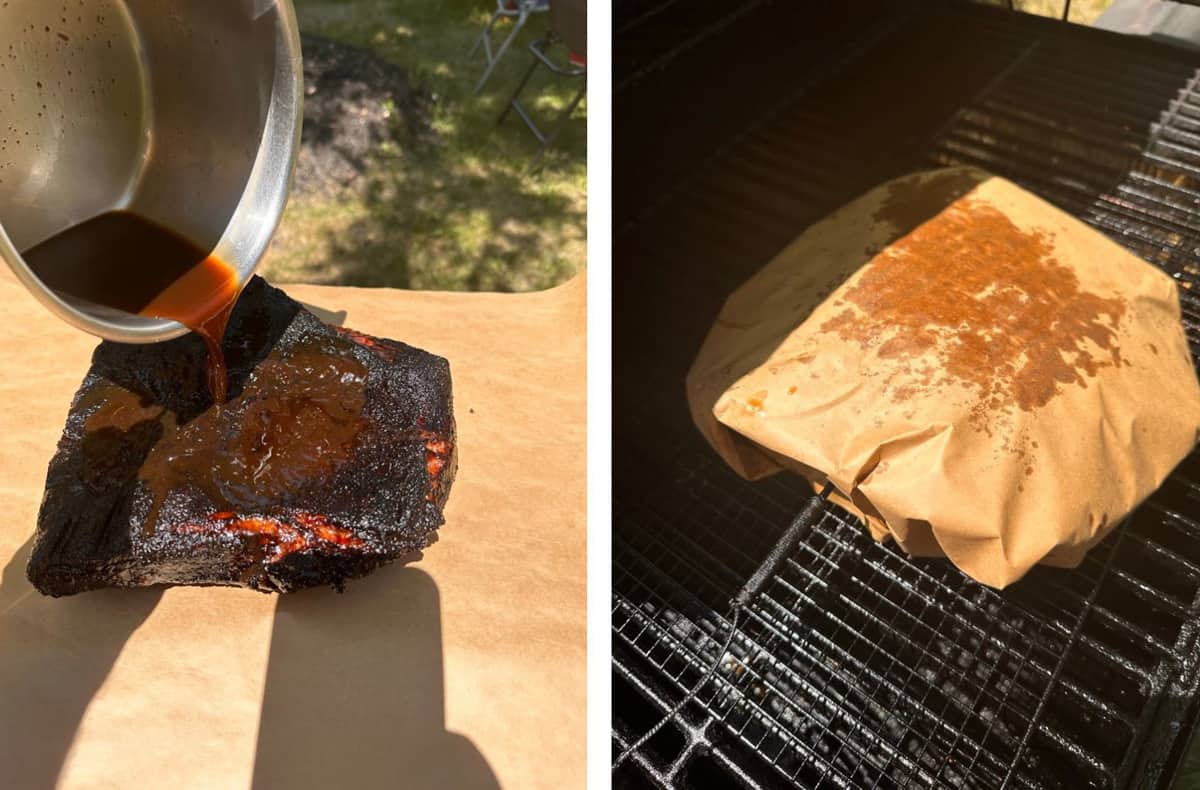
How to finish a wrapped brisket in the oven
If you’ve been smoking your brisket and want to finish it off in the oven, here’s a quick and simple guide.
- After you’ve wrapped your brisket in aluminum foil, preheat your oven to 225 degrees Fahrenheit.
- Place the wrapped brisket on a rimmed baking tray to catch any drippings and slide it into the oven.
- Cook until the brisket’s internal temperature reaches 205 degrees Fahrenheit, which you can check using an instant-read thermometer.
- Then, let your brisket rest for at least an hour before slicing to allow the juices to redistribute.
You may lose some of the crispness of the bark if you finish it in the oven. But after 10 hours or so of the smoking process, you will not care, believe me! The flavor will still be outstanding.
Optional: Brisket Foil Boat Method
The “boat method” is a clever way to finish a brisket flat that gives you the best of both worlds: it helps lock in moisture without sacrificing that bark you’ve worked hard to build.
How it Works: Instead of wrapping the brisket tightly in foil or butcher paper, you set it in a shallow foil tray or “boat.” You shape the foil around the bottom and sides of the brisket, leaving the top mostly exposed. This protects the bottom of the meat from drying out and lets it sit in its own juices, while the top continues to firm up and build bark. It’s like a gentle braise with airflow.
This method is especially helpful if your bark is almost where you want it but your brisket still needs to climb to temp. It also makes transferring the brisket easier and keeps your smoker cleaner. Some folks will pour in a bit of beef broth or their spritz mix for extra moisture, but that’s totally optional.
Timeline for making a smoked brisket flat (10 to 12 Hours)
If you’re wondering how long it takes to make a smoked brisket flatt, add a couple of hours to your best guess. In general, plan on about an hour and a half per pound of meat. So, for a 7 lbs brisket, you’re looking at about 10 hours, start to finish.
The timeline assumes that the smoker maintains a consistent temperature of 250° F. throughout the smoking process. Adjustments may be needed based on individual preferences and variations in cooking equipment and the total weight of your brisket flat.
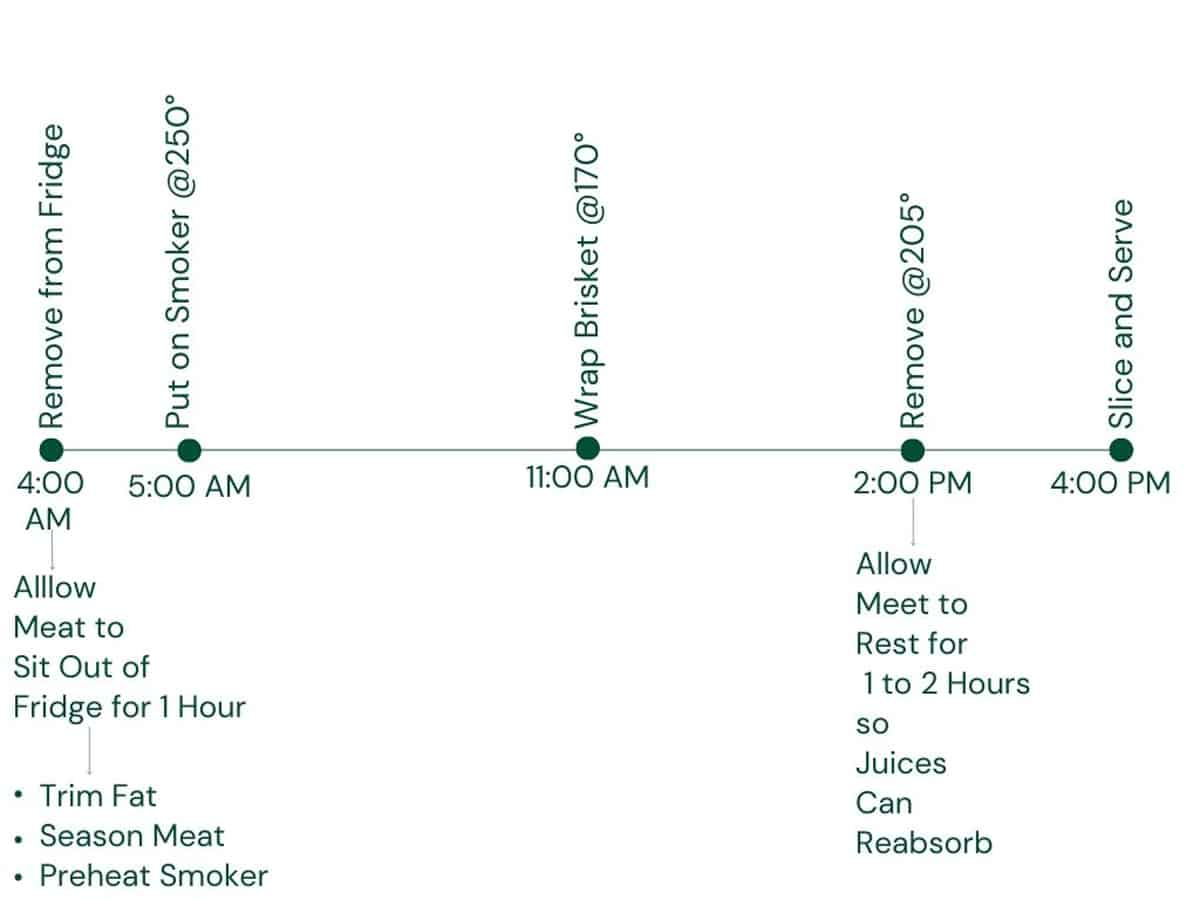
How to Get a Good Bark on Brisket
Here’s the real deal on how to get a great bark on your smoked brisket flat. Not just the usual tips you’ve already heard, but some insights from the trenches that come straight from the smoker.
1. Keep It Simple and Dry
After trimming, pat the brisket flat dry with paper towels. Skip the mustard or oil. Those can block smoke from sticking to the meat. You want the surface dry to the touch but still a bit tacky. That helps the rub cling and starts the bark-building process right from the beginning.
2. Use a Coarse Rub That Can Handle the Heat
Kosher salt and freshly ground black pepper are all you really need. But the grind matters. Fine seasoning melts into the meat. Coarse seasoning stays put and helps form the crust. If you want to add something extra like garlic or onion powder, use just a pinch. Too much fine powder will gum up and ruin the texture of the bark.
3. Let It Sit Before Smoking
After seasoning, let the brisket sit out at room temperature for 45 minutes to an hour. This gives the salt time to pull moisture to the surface, which helps lock the rub in place. It also takes the chill off the meat so it cooks more evenly once it hits the smoker.
4. Create a Steady Draft
This step gets ignored a lot. Good airflow is just as important as temperature. A consistent draw of clean smoke over the meat helps the bark form properly. If the smoke is heavy or stale, the bark can end up soft or bitter. Keep the exhaust vent open and control your intake vents to keep things moving.
5. Spritz Smarter, Not More
Hold off on spritzing until about 90 minutes into the cook. Before that, the rub is still bonding with the meat. When you do spritz, just give it a light mist with apple cider vinegar or a 50-50 mix with water. You want to keep the surface moist enough to attract smoke but not so wet that it steams or washes off the bark.
6. Know When to Wrap (and When Not To)
Aim to wrap your brisket flat when the internal temp hits around 170 degrees. But let your eyes guide you too. If the bark still looks pale or soft, give it more time. A well-developed bark should look dry, dark, and a little crusty before you wrap it up.
7. Rest Unwrapped for a Few Minutes
Here’s a tip most folks skip. After your brisket reaches 205 degrees and comes off the smoker, let it rest unwrapped for about 10 to 15 minutes. This short break helps the bark firm up just a bit more before you rewrap it and hold it in a cooler or warm oven. It’s a small step that can make a big difference in the final texture.
Pro Tip
A beautiful bark doesn’t happen by accident. It starts with how you prep the meat and continues with how you manage heat, smoke, and moisture throughout the cook. Treat every step as part of building that crust and you’ll get bark that’s dark, flavorful, and just the right amount of chewy.
10 Mistakes to Avoid when Smoking a Brisket Flat
Here’s a no-nonsense list of what usually goes wrong when smoking a brisket flat, and how to avoid each mistake. These are the things that frustrate home cooks the most and can turn a good brisket into a dry or rubbery mess.
1. Bad Cut of Meat
A brisket flat that’s too lean or uneven won’t cook well.
What to do: Look for Choice or Prime grade with even thickness and visible marbling.
2. Poor Trimming
Too much fat or silver skin keeps smoke and rub from sticking.
What to do: Trim the fat cap to about 1/4 inch and clean up the surface.
3. Overseasoning or Fine Rubs
Heavy or powdery rubs can turn to mush.
What to do: Keep it simple with coarse salt and pepper, applied evenly.
4. Meat Is Too Cold
Cold brisket cooks unevenly.
What to do: Let it sit out for about an hour before it hits the smoker.
5. Inconsistent Temperature
Big swings in heat ruin the cook.
What to do: Hold a steady 250°F and use a good thermometer.
6. Wrapping Too Early
Wrapping before the bark sets gives you soft, steamed brisket.
What to do: Wait until it hits around 170°F and the bark feels firm.
7. Over-spritzing
Too much spray can wash off your bark.
What to do: Lightly mist every 45 minutes, starting after the first 90 minutes.
8. Wrong Final Temp
Under or overcooked brisket ruins texture.
What to do: Aim for an internal temp of 203 to 205°F and check with a meat probe.
9. Skipping the Rest
Slicing too early lets all the juices escape.
What to do: Let it rest wrapped for at least 30 minutes, up to 2 hours if you can.
10. Opening the Lid Too Much
Peeking drops your temp and stalls the cook.
What to do: Use a remote probe and trust the process. No need to babysit.
Avoid these, and your brisket flat has a much better shot at being juicy, tender, and packed with flavor.
Switch it up: Variations and Substitutions
Got a brisket point or a whole packer? No problem! The point cut has more fat which lends itself to slow cooking beautifully. The smoking time will just take longer because it is thicker than a flat.
If you don’t have a pellet grill or offset smoker, it’s also easy to make a smoked brisket flat in an electric smoker. I’ve used all three types of smokers and I find that the quality of smoke from an offset smoker is hands-down superior to the other types.
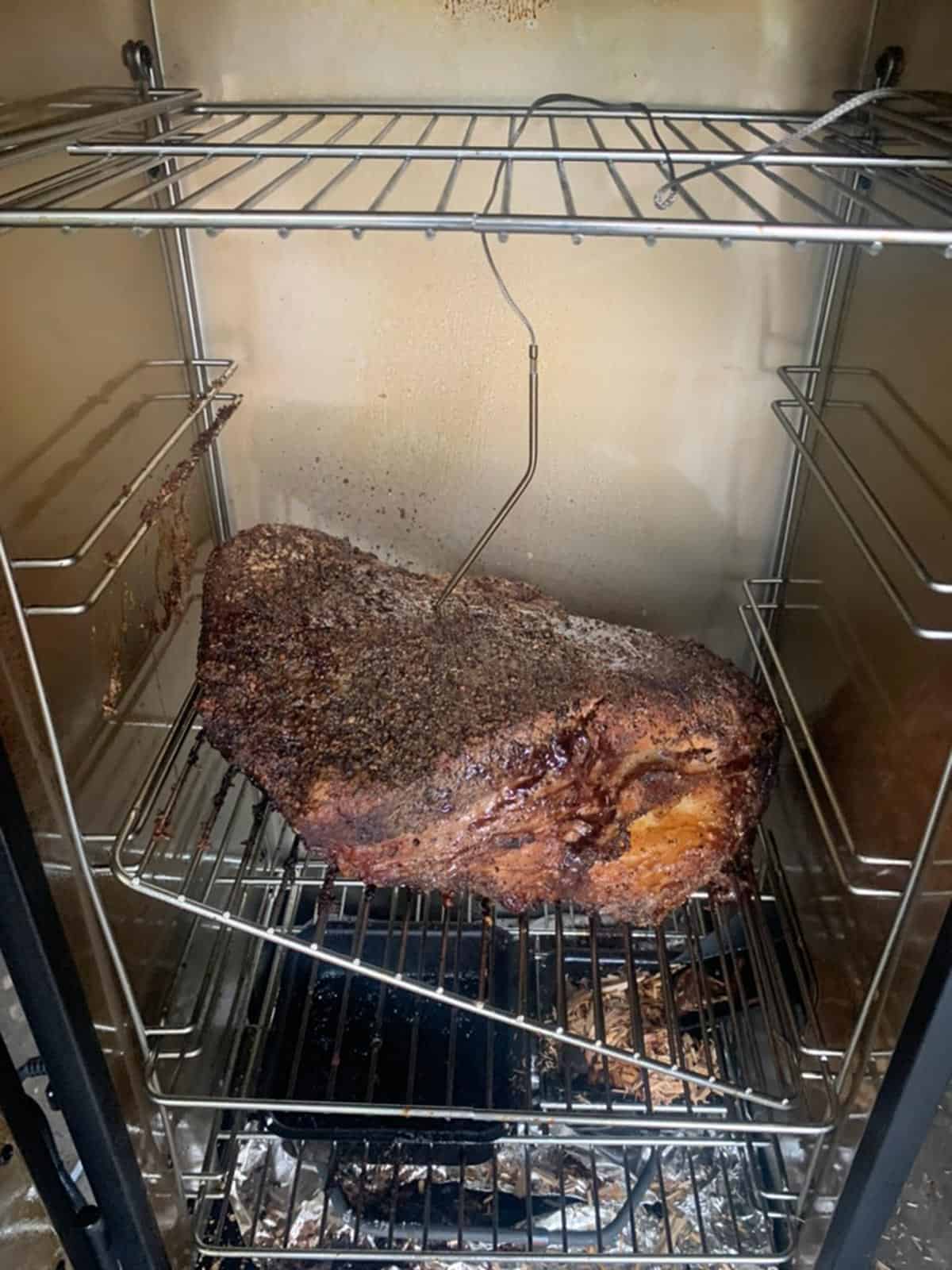
A charcoal grill will work just fine, too, and it might even add some extra smoky flavors.
And while a traditional rub of kosher salt and black pepper is a classic for a reason, don’t be afraid to experiment with a dry rub for a smoked brisket flat.
Add garlic powder or onion powder for a punch of flavor, or sprinkle in some brown sugar for a hint of sweetness to balance the spice.
Follow these tips, and you’re on your way to mastering the art of smoking brisket!
What to Serve with Smoked Brisket Flat
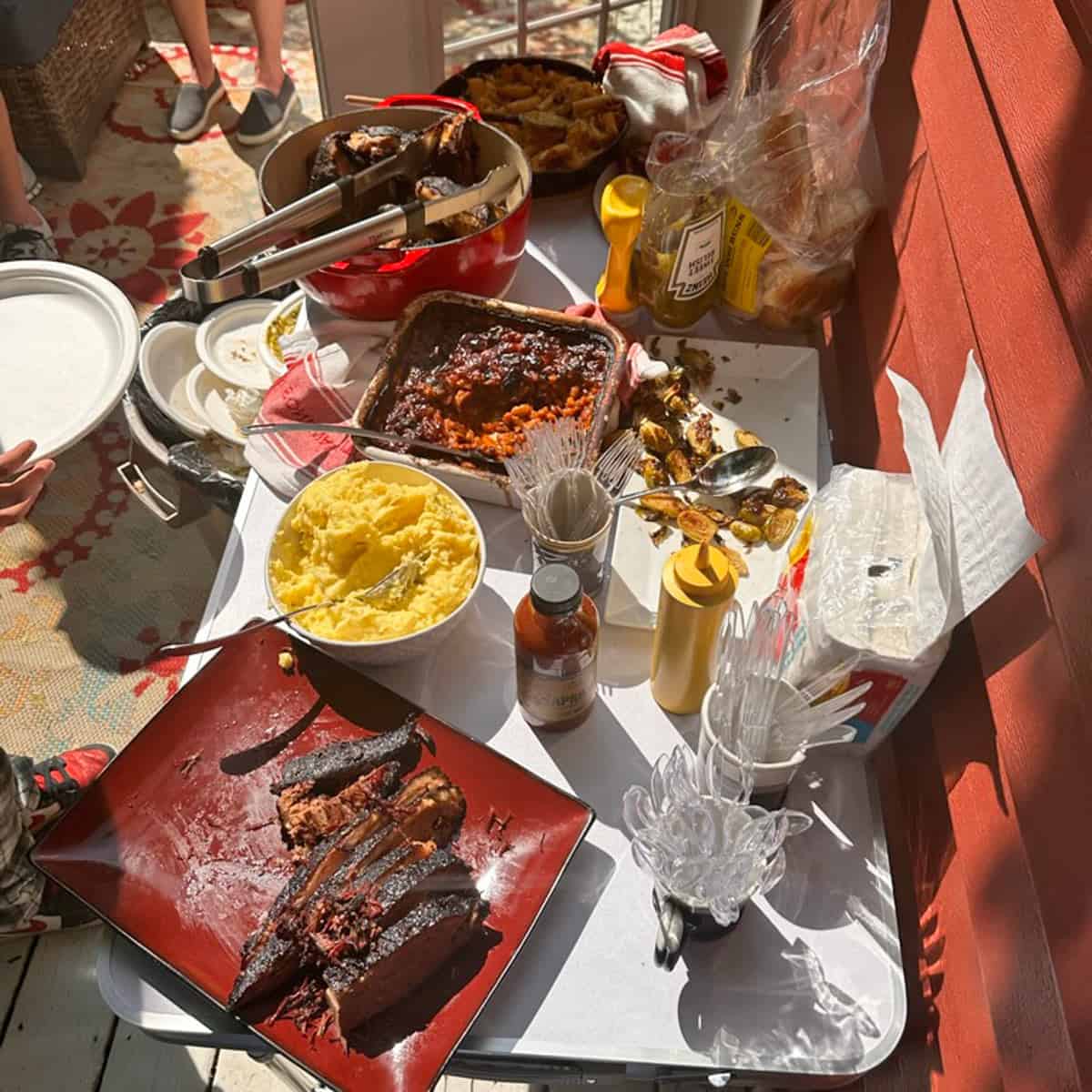
Your smoked brisket flat is going to be the star of the show, no doubt. But even stars shine brighter with a supporting cast.
Creamy coleslaw or bacon-ranch potato salad, BBQ baked beans from the instant pot, creamy baked mac and cheese, Mandarine orange lettuce salad, or even a simple slice of homemade white crusty bread and some pickles can cut through the richness of the smoky flavors, making each bite of brisket even more better tasting. For a little color, try a batch of our maple and balsamic glazed rainbow carrots, they’re out of this world delicious!
It might seem like a tall order if this is your first time cooking brisket. But don’t worry. With this guide, you’re in the right place.
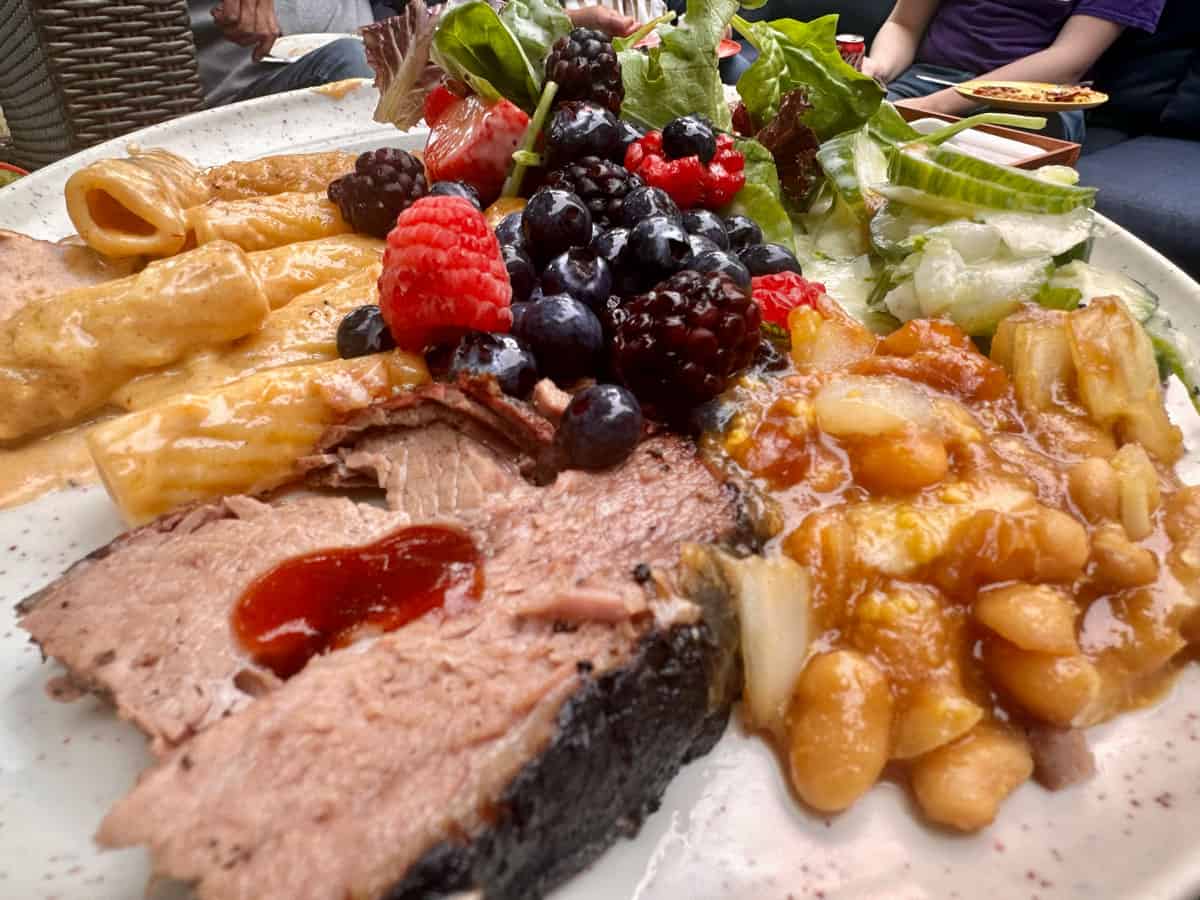
Recipe Questions and Answers
Figure on about 1/2 lb of brisket per person. After trimming the fat, a 7 lb brisket flat should easily feed 10 people. We wrote an entire post on how much brisket you need per person. Be sure and check it out!
Good question! You’ll want to trim off any excess fat, leaving about a quarter-inch layer. This layer of fat (the fat cap) will protect the leaner sides of the brisket from drying out during the long cooking time.
Use a sharp knife to carefully remove any excess fat or silver skin from the surface of the meat.
An instant-read thermometer is your best friend when smoking a brisket flat. Aim for a temperature of 250-275 degrees Fahrenheit in your heat source (your grill or smoker).
Keep a close eye on the meat’s internal temperature as it cooks to ensure it’s progressing nicely.
The thickest part of the brisket will give you the most accurate reading.
You’re aiming for an internal temperature between 203-205 degrees Fahrenheit. I find that a finish temp of 205° will give you the best results. My guests have confirmed this, who have tried many brisket flats that I have smoked to various temperatures! When your brisket hits this sweet spot, you’re guaranteed a tender, juicy brisket that’s cooked to perfection.
How to use Leftover Smoked Brisket
If you have leftovers, consider yourself lucky! I don’t always have leftovers after making a smoked brisket flat, but when i do, there are so many ways I like to use it.
- Make a meat-lover’s mac and cheese.
- Add it to a mushroom and microgreens omelette. (Be sure and heat the meat up first.)
- Use it in these easy beef enchiladas.
- Make a leftover beef pot pie out of it.
- Make leftover brisket tacos.
- Enjoy it in a sandwhich.
The satisfaction of achieving that tender, perfectly cooked brisket, complete with a good, crusty bark, is worth every minute spent. It’s all about patience, attention to detail, and of course, love for good BBQ.
So grab that sharp knife, prepare your dry rub, and get ready to taste the best smoked brisket you’ve ever had. Enjoy the journey, and happy smoking! -Dan
Take a look at our favorite grilling and smoker accessories. We use these products all the time!
More Great Smoker Recipes
Grill and Smoker Recipes
The BEST Smoked Pork Tenderloin
Grill and Smoker Recipes
The BEST Traeger Smoked Beef Tenderloin
Grill and Smoker Recipes
How to Use a Smoke Tube for Smoking Meat
Grill and Smoker Recipes
Best Cuts of Beef to Smoke (and Smoked to Perfection)
👨🍳 Tried this Recipe? Please leave a ⭐⭐⭐⭐⭐ rating in the recipe card below and leave a comment. We love hearing from our readers!
⏩ Stay in touch with us on social media by following us on Facebook, Pinterest, Instagram, and YouTube!
📬Get our Recipes delivered to your inbox for FREE!
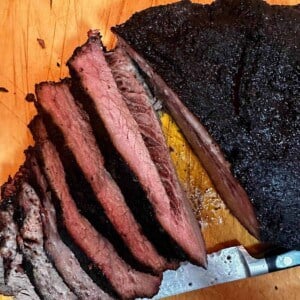
Smoked Brisket Flat
Want to Save This Recipe, Friend?
Ingredients
- 7 lb brisket flat, trimmed and seasoned
- 1 tbsp kosher salt
- 1 tbsp fresh ground pepper
For the Basting Liquid
- 1/4 cup beef broth
- 1 tbsp Worcestershire sauce
Instructions
- Remove the meat from your refrigerator for 1-2 hours before putting it on your smoker. Trim the fat while the meat is still cold, and then evenly season with salt and pepper. Meanwhile, preheat your smoker to 250°
- After the smoker comes to temperature, place a water pan below the grates and pour a quart of hot water into it. Then, place the meat in the smoker chamber with the thickest end facing the heat source. If using a temp probe, insert it into the thickest part of the meat.
- After 2 hours on the smoker, begin to spray the meat with apple cider vinegar every 45 minutes to an hour, to help keep it from drying out.
- When the meat reaches an internal temperature of 160°, wrap it in butcher paper, with the basting liquid, and continue to smoke it until it reaches an internal temperature of 205°. If you want to finish the brisket flat in an oven, wrap with tight foil, along with the liquid, and finish it off in a preheated oven at 225°.
- When the internal temperature of the brisket flat reaches an internal temperature of 205°, remove it from the smoker (or the oven) and allow it to rest, still wrapped, for a minimum of 30 minutes and up to 2 hours.
Notes
- Trim the fat while the meat is still chilled.
- Let the meat set out for at least an hour before placing it on the smoker. Do not let it sit out for longer than two hours to help prevent foodborne illness.
- Closely monitor the temperature of your smoker and spray the meat with liquid every hour or so.
- Do not overcook the meat. Do not allow it to exceed an internal temperature of 205° F.
- Allow the meat to rest for a minimum of 30 minutes before serving, but an hour is even better. This is essential for allowing the meat fibers to reabsorb the juices after it comes off the smoker (or out of the oven.)
Nutrition
Nutrition information is automatically calculated, so should only be used as an approximation.
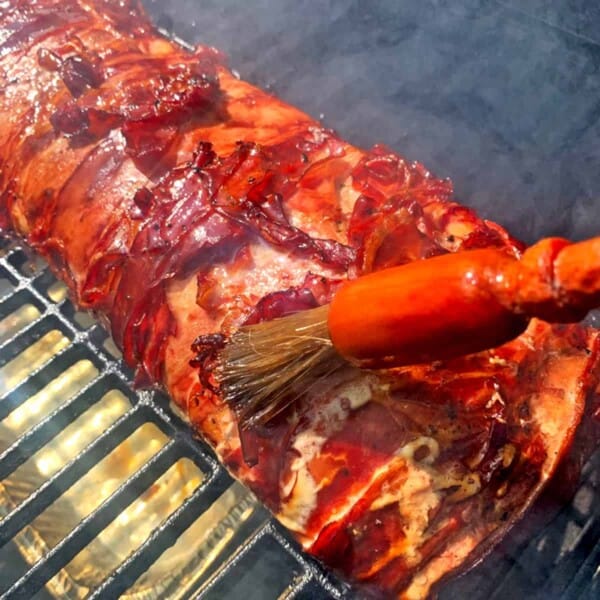
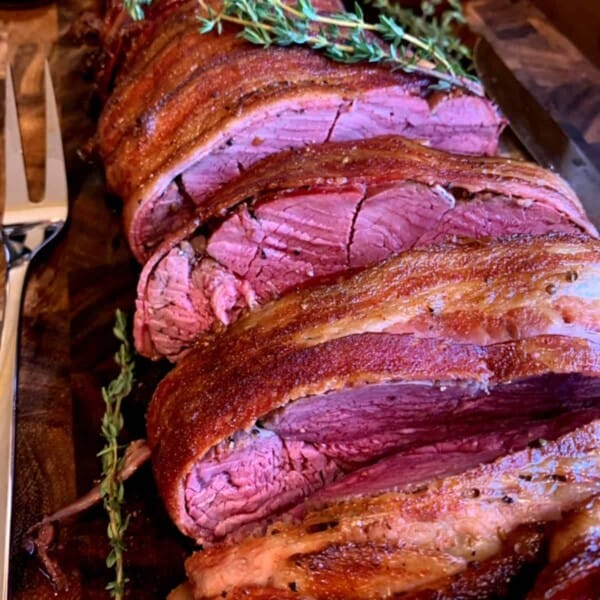

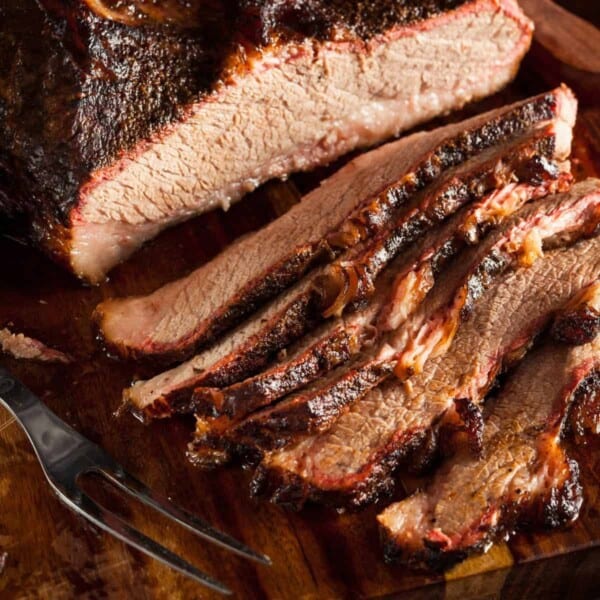













Did my first brisket flat tonight which was only 3 lbs. Started cooking too quickly at 250 f, so took it down to 180 for two hours. Followed the rest of your recipe minus some Meat Church seasoning. Turned out moist and flawless!
Only edit to the recipe for newbies like me is to not soak your butcher paper with juice. A spritzed paper works fine!
Rachel, I’m sorry I missed it!!! I thought about smoking one this weekend but at least I know that someone did and it sounds like it was a success!!! Thanks so much for taking the time to comment!